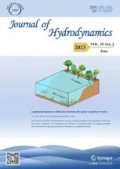Abstract
A comparison of theoretical investigation and numerical simulation of a single bubble oscillation is carried out in this paper. The theoretical research is based on solving Rayleigh-Plesset (R-P) equation and Keller-Miksis (K-M) equation using Runge-Kutta method. The numerical method focuses on the two discrete methods in the volume of fluid (VOF) method, geometric reconstruction (GR) and modified high resolution interface capturing (MHRIC). The results show that the interface captured by MHRIC in the collapse stage is more stable, and the evolution of bubble radius agrees better with the theoretical solution. The R-P equation and K-M equation, which omit the effect of the energy equation, have limitations when the bubble collapses under ultra-high pressure.
Similar content being viewed by others
References
Rayleigh L. On the pressure developed in a liquid during the collapse of a spherical cavity [J]. The London, Edinburgh, and Dublin Philosophical Magazine and Journal of Science, 1917, 34(200): 94–98.
Plesset M. S., Chapman R. B. Collapse of an initially spherical vapor cavity in the neighborhood of a solid boundary [J]. Journal of Fluid Mechanics, 1971, 47: 283–290.
Keller J. B. Bubble oscillations of large amplitude [J]. Acoustical Society of America Journal, 1980, 68(2): 628–633.
Lauterborn W., Kurz T., Mettin R. et al. Experimental and theoretical bubble dynamics [J]. Advances in Chemical Physics, 1999, 110: 295–380.
Peng X. X., Zhang L. X., Wang B. L. et al. Study of tip vortex cavitation inception and vortex singing [J]. Journal of Hydrodynamics, 2019, 31(6): 1170–1177.
Philipp A., Lauterborn W. Cavitation erosion by single laser-produced bubbles [J]. Journal of Fluid Mechanics, 2000, 361: 75–116.
Guo W. L., Li H. C., Wang J. Z. et al. Reaserch progress on interaction between a single cavitation and free surface [J]. Chinese Journal of Theoretical and Applied Mechanics, 2019, 51(6): 1682–1698(in Chinese).
Krefting D., Mettin R., Lauterborn W. High-speed observation of acoustic cavitation erosion in multibubble systems [J]. Ultrasonics Sonochemistry, 2004, 11(3-4): 119–123.
Koukouvinis P., Gavaises M., Supponen O. et al. Numerical simulation of a collapsing bubble subject to gravity [J]. Physics of Fluids, 2016, 28(3): 032110.
Krninger D., Khler K., Kurz T. et al. Particle tracking velocimetry of the flow field around a collapsing cavitation bubble [J]. Experiments in Fluids, 2010, 48(3): 395–408.
Zhang A. M., Li S., Cui J. Study on splitting of a toroidal bubble near a rigid boundary [J]. Physics of Fluids, 2015, 27(6): 062102.
Brennen C. E. Fundamentals of multiphase flow [M]. Cambridge, UK: Cambridge University Press, 2009.
Prosperetti A, Tryggvason G. Computational methods for multiphase flow [M]. Cambridge, UK: Cambridge University Press, 2009.
Huang X., Wang Q. X., Zhang A. M. et al. Dynamic behaviour of a two-microbubble system under ultrasonic wave excitation [J]. Ultrasonics Sonochemistry, 2018, 43: 166–174.
Liu J. L., Xiao W., Yao X. L. et al. Dynamics of a bubble in a liquid fully confined by an elastic boundary [J]. Physics of Fluids, 2021, 33(6): 063303.
Wang J. X., Liu K., Jiang M. Z. et al. Numerical simulation of the coupled response of stiffened structures subjected to explosion bubble loading [J]. Journal of Marine Science and Technology, 2020, 25(4): 1103–1119.
Koch M., Lechner C., Reuter F. et al. Numerical modeling of laser generated cavitation bubbles with the finite volume and volume of fluid method, using OpenFOAM [J]. Computers and Fluids, 2016, 126: 71–90.
Lechner C., Koch M., Lauterborn W. et al. Pressure and tension waves from bubble collapse near a solid boundary: A numerical approach [J]. The Journal of the Acoustical Society of America, 2017, 142(6): 3649–3659.
Koukouvinis P., Gavaises M., Supponen O. et al. Simulation of bubble expansion and collapse in the vicinity of a free surface [J]. Physics of Fluids, 2016, 28(5): 052103.
Osterman A., Dular M., Sirok B. Numerical simulation of a near-wall bubble collapse in an ultrasonic-field [J]. Journal of Fluid Science and Technology, 2009, 4(1): 210–221.
Tang H., Liu Y. L., Cui P. et al. Numerical study on the bubble dynamics in a broken confined domain [J]. Journal of Hydrodynamics, 2020, 32(6): 1029–1042.
Hirt C. W., Nichols B. D. Volume of fluid (VOF) method for the dynamics of free boundaries [J]. Journal of Computational Physics, 1981, 39(1): 201–225.
Muzaferija S., Peric M., Sames P. et al. A two-fluid Navier-Stokes solver to simulate water entry [C]. Proceedings of the 22nd Symposium on Naval Hydrodynamics, Washington DC, USA, 1998, 277–289.
van Leer B. Toward the ultimate conservative difference scheme. IV. A second order sequel to Godunov's method [J]. Journal of Computational Physics, 1979, 32: 101–136.
Author information
Authors and Affiliations
Corresponding author
Additional information
Projects supported by the National Project of China (Grant No. 6140206040301).
Biography: Jie-min Zhan (1963-), Male, Ph. D., Professor
Rights and permissions
About this article
Cite this article
Zhan, Jm., Chen, Yh. & Li, Yt. Research on theoretical and numerical methods of single bubble oscillation. J Hydrodyn 33, 872–877 (2021). https://doi.org/10.1007/s42241-021-0076-y
Received:
Revised:
Accepted:
Published:
Issue Date:
DOI: https://doi.org/10.1007/s42241-021-0076-y


